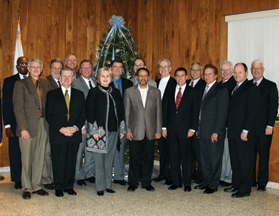Well, I think my last "Sanctuary Sights and Senses" post was back on January 28, 2011! For those who do not recall, or those who were not reading this blog during 2010, "Sanctuary Sights and Senses" originated as a series of bulletin inserts for my local church. I would write the inserts, and I would then post them on the blog. And, after almost a year, I have a new insert; this one on the Gospel Procession.
I have to say I am excited about this, because this will be the first time we have actually processed the Scriptures for the Gospel reading, but, as you will see, what better time to begin this act of worship than on Christmas Day?!
I have to say I am excited about this, because this will be the first time we have actually processed the Scriptures for the Gospel reading, but, as you will see, what better time to begin this act of worship than on Christmas Day?!
The other exciting thing is that, after talking with colleagues (especially the Rev'd. Dr. Brook Thelander at Epworth Chapel on the Green ), I found out that one can purchase liturgical binders, in which one can place copies of each Sunday's lectionary readings, and which is designed for liturgical processions. These binders are considerably less expensive than purchasing the entire Lectionary book for liturgical readings or the Gospel Books. Then, while talking with my Administrative Assistant, she informed me that she and her husband could simply make an appropriate, decorative covering for one of my binders! - I'm quite excited!
Anyway, the actual "Sanctuary Sights and Senses" follows:
Gospel Procession - In many churches, when it is time to read the Gospel lesson, the Scriptures are processed out into the center of the congregation. As this takes place, the congregation stands for the reading of the Gospel.
Often it is said, prior to the reading, “The Holy Gospel of our Lord Jesus Christ according to [Scripture reference].” And the congregation responds, “Glory to you, Lord Christ.”
During this announcement, Christians may choose to make the sign of the cross on their foreheads, lips and over their hearts. This signing symbolizes the prayer that the Word will be in our minds, upon our lips, and in our hearts.
Following the reading of the Gospel, the declaration is made, “The Gospel of the Lord,” to which the congregation responds, “Praise to you, Lord Christ!”
The Old Testament reading points us ahead to Christ. The Epistle reading points us back to Christ. But, in the Gospel reading, we hear the words of Christ, Himself. (Though, in a very true sense, we hear the Word of the Lord in every part of Scripture.)
Because, we hear Christ’s words in the Gospel, the procession of the Gospel into the midst of the congregation symbolizes for us the Incarnation; the coming of God in Christ to us, in our very midst; the Word made flesh. - This symbolism is heightened for us during Christmas, of all times, when we especially celebrate the Incarnation of Christ our Lord!







